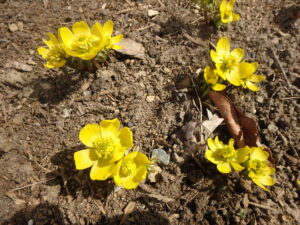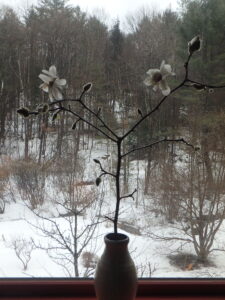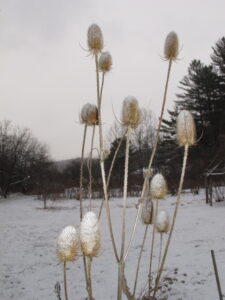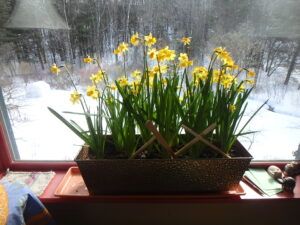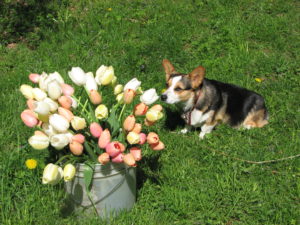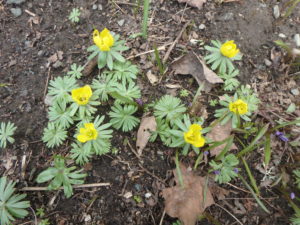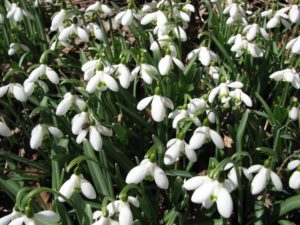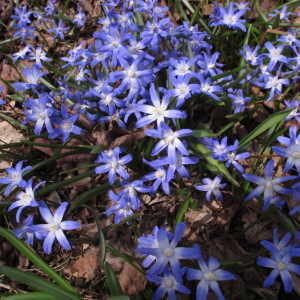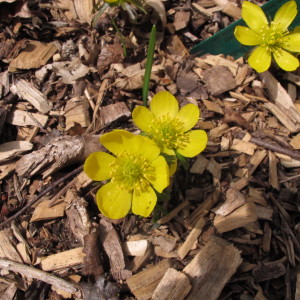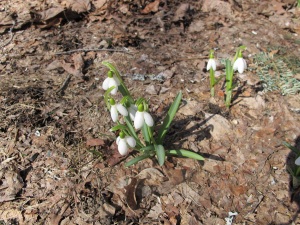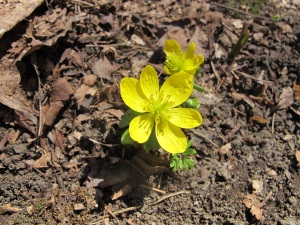Arrangements for Early Spring
I miss being able to go to my garden and pick flowers for the table. Yes, spring is on the way and even feels present on good days now. But it will be awhile until my daffodils and tulips bloom. My winter aconite, small yellow bulb flowers, are blooming, and little white snowdrops have pushed through frozen earth. Those mini-flowers aren’t really suitable for a bouquet, but I’ve picked a few things that please me.
First, I picked some stems from my ‘Merrill’ magnolia. It is loaded with fuzzy buds for its late-April blooming, and these look good in an arrangement. Magnolia branches tend to fork and grow in different directions, so placing stems in a vase can be tricky. I put some in a dry vase with dried flowers and seed-bearing stems and one in a vase with water to put on a windowsill. The buds I picked on January 31 bloomed on March 17.
Then there are the hydrangeas. Many species and varieties hold onto their flower panicles well into winter and can be quite nice in a vase. My favorite is one called ‘Pink Diamond’. It has long stems and it holds onto the fertile and infertile inflorescences, showing contrast between white and black florets on the panicles. Although the blossoms are pink toward the end of their bloom cycle, they are not pink after frost.
Astilbes bloom magnificently for me, and their winter stems are great in a dry vase. I have many different species and varieties ranging from short (12-inch blossom stems) to tall (48-inches). Their chief requirement is moist soil, and I have plenty of that. If you don’t have moist soil, the leaves will brown up in the heat of summer. One trick I have tried in dry locations is to bury a plastic bag a foot or so deep in the soil before planting. That will act like a little bathtub and hold some water in dry times. They like a half day of sunshine, and prefer morning sun.
Of course, the best color in the house for me right now are my forced daffodils. Last fall I potted up plenty of “tete-a-tete” daffodils and kept them in my cold cellar until recently. Each bulb provided many blossoms and even now, after the flowers have gone by, they are still pleasant looking with green leaves and dried yellow flowers.
The Spring Bulb Flowers
Now is the time to decide where you should plant bulbs next fall. Here’s what I do: I wander around my property each year in the spring to see what spots are bare of bulb flowers. I bring along those white plastic markers used for labeling, and write “add crocus here”, for example. Then in the fall, when it’s time to plant more bulbs I don’t have to rely on my memory to know what to plant, and where.
When planting bulbs, I label what I‘ve planted. That way I’ll see what has performed well, and remember to buy more of the same. For example, I’m always eager to get color in the garden at the same time that the white snowdrops bloom. Two purple-blue bulbs bloom about the same time: Glory-of-the-snow is one plant that overlaps with snowdrops, but is a bit later, as is scilla.
This spring I saw a crocus that was labeled ‘Blue Pearl’, that is blooming with my snowdrops – and before those other two. So I’ll buy 100 of those for fall planting. I bought them at Brent and Becky’s Bulbs– I know because they include tags with each bag of bulbs. And I can order them now for delivery then.
This year I am delighted to see that the winter aconite that produced seed 2 years ago is going to bloom. Last year I recognized the leaves, but it did not produce blossoms. It is a very early bright yellow flower that has one-inch wide, six-petaled flowers. I’ve grown it before but lost it to cold or rodents or poor drainage, and re-planted in other spots. This new patch will give me 50 or so “free” flowers.
I tend to blame bulb failure on drainage problems, not rodents. I mix in lots of compost at planting time and favor hillsides, which helps with drainage. Wet soil is hard on bulbs. Our cats tend to keep rodents away. South facing hillsides are great for early bulbs as the snow melts off weeks earlier than north-facing plots, and drain well.
A bulb plant that I’ve considered fussy is a low-growing iris, Iris reticulata. It is just a few inches tall and has medium-sized blue, purple or (sometimes) yellow flowers. Doing some research I found out why I thought they are fussy: after they bloom, the bulbs divide, producing several little bulblets. These won’t bloom for a few years. So I need to plant some every year until I have a mature colony of them. I also read that they like soil that dries out well in summer, such as in a rock garden or sandy hillside.
My lawn is full of snowdrops that have planted themselves. I assume that they produce seeds that wash into the lawn during summer rains. The bulk of my snowdrops are planted on a hillside above the lawn. But you can plant early spring bulbs in the lawn, too. Just don’t plant daffodils or anything with large leaves because you won’t be able to mow the lawn where they are growing until the leaves yellow and dry off – around July 4th. Bulb plants need to re-charge their batteries, if you will, by getting sunshine and storing energy.
Little bulbs like snowdrops, crocus and grape hyacinths have short leaves that disappear early and won’t disrupt your early mowing. You can always set the lawn mower blades high to protect the leaves if they are still green when you need to cut the lawn.
Grape hyacinths (Muscari spp.) are great little flowers that come in many different shades of blue and purple. I’ve planted many dozens in my day, but find they tend to lose vigor and disappear with time. So I plant them again. Whenever I see grape hyacinths for sale in pots at the grocery store, I buy them. I enjoy them immensely in the house. Later, when the soil is thawed, I plant them outside. I keep the pot in a cool space indoors, as if they get too warm, they flop over.
Tulips I treat like annuals. Why? They do well the first year, but quickly go downhill or disappear in subsequent years no matter what I do. I plant 100 most years in a bed that I reserve for them. Later I plant zinnias in the same bed, so I don’t bother to coddle them. My corgi, Daphne, keeps the deer away.
Daffodils are slightly poisonous to deer and rodents, so they aren’t eaten – and can bloom for years. You can plant them in open woodlands and they will do fine. By the way, if you forced paperwhites this winter, don’t bother planting them outdoors – they’re not hardy here.
I’ve been paying attention to bulb flowers at least since I was 9 years old. I recently found entries in my diary that tell me so. My entry for March 7, 1956, in its entirety was this: “Spring is getting here at last the snow drops are in bud + will bloom in a few days.” Then on April 5 I wrote,” Today our first crocus was in bloom it is very pretty.” As a guy who makes his living writing, I no longer keep a daily journal. I tend to document my life now with a digital camera – and this column. Thanks for keeping me writing!
Henry lives and gardens in Cornish Flat, NH. You may reach him at henry.homeyer@comcast.net. He is the author of 4 gardening books.
Planting Bulbs
After a long winter like this past one, I am always grateful for my spring bulbs. Many of them pop up and bloom on schedule, no matter how cold and snowy the winter was. I’ve been planting bulbs around my property since the early 1970’s, and some of them are still flowering each spring. Others run out of energy and disappear with time. If you haven’t done so yet, now is the time to get some and plant them.
First, let’s look at the basics: what makes a bulb plant survive and flourish? Decent soil. It must be well drained. Soggy soil rots bulbs. If you have a heavy clay soil, it will stay wet and is not a good place for bulbs unless you add compost to the planting hole to help it drain better. Planting on a hillside helps, too, as water will drain off a hillside.
Bulb flowers take shade better than sun-loving perennials. Growing up we had hundreds of daffodils that bloomed along a woodland path behind the house. The leaves got sunshine and re-charged the bulbs before the trees were fully leafed out. Of course if you have plenty of sunshine, all the better.
Some people have had great luck planting daffodils in a grassy field or lawn. I’ve done that, but find that the bulb foliage is still green and producing food for the bulb when the lawn needs to be cut. If you cut the foliage too early, your bulbs won’t perform as well. I like to plant daffodils in flower beds between big clumps of hostas. They can bloom early, and then their dying foliage is hidden by the hosta leaves.
Some gardeners dig a little hole for each bulb, but that seems like too much work for me, even if you have one of those tools that are made for digging small round holes. I’d rather use my shovel to dig one oversized hole, one big enough for the 25 bulbs or more. For large bulbs like daffodils or tulips a hole 24 to 36 inches long and 18 to 24 inches wide is fine for 25 bulbs.
For the big bulbs I dig a hole 6 to 8 inches deep. Then I add compost and some organic fertilizer or “bulb booster” fertilizer and stir it into the bottom of the hole. I place the bulbs on the improved soil, pointy end up, and cover with more improved soil.
What about those hungry, bulb-stealing squirrels? They don’t eat daffodils as they are vaguely poisonous. They may dig a few up to see what you planted, but they won’t eat them. “Yech,” they say, if they inadvertently take a bite.
When I interviewed the White House gardener in 1999 he said they planted thousands of tulips each year, despite the rampant squirrels. He said they planted the tulips and covered them with soil, then put down a layer of chicken wire, then more soil. Oh, and he said they fed the squirrels all winter with cracked corn. Squirrels that are not hungry are less likely to try to steal your bulbs. Squirrel welfare.
Some people have great luck with tulips coming back, but I consider them annuals. In general, I find that the second year only half the tulips come back to bloom, the third year only half of those come back and so on. But I often plant 100 tulips, all one color for a blast of color in spring. I particularly like the tall ones that bloom a bit later.
‘Maureen’ is one of my favorite tulips. She is a 28 inch tall tulip, a creamy white that blooms in May. ‘Menton’ blooms at the same time and is rose-pink with apricot-pink petal edges and is 26 inches tall. Wow. They make a nice mix. I have already ordered 100 of each! That way I’ll have too many flowers, and can give away big bunches of them when they bloom.
If you consider your tulips annuals, you can plant them in your vegetable garden and pull them after blooming. Then you can plant tomatoes or something else there. And if you have a deer problem, you can easily fence a small plot for 100 tulips with 4 poles and some bird netting. If you want to mix them into your flower gardens, plant them where you’ll plant annual flowers. When the tulips are done blooming, it will be time to plant annuals.
The little bulbs are great early harbingers of spring, particularly snowdrops. Snowdrops are small white globes on 4 inch stems. Mine fight through frozen soil in early March. Some years (when we have deep snow) I shovel snow off the hillside where they appear so they can bloom on schedule. Each year I have more, so now, after decades, I have a thousand or more.
Other early bloomers include winter aconite (Eranthis hyemalis), a small up-ward looking 6-petaled brilliant yellow flower. Another favorite of mine is glory-of-the-snow (Chionodoxa luciliae). This is a nice blue, with a yellow eye. It blooms shortly after the snowdrops in April.
I can’t praise the spring bulbs enough. I consider them essential for my wellbeing. So order some, or go to your garden center and buy some. You’ll be glad in a few months.
Henry is on vacation this week and will not be answering questions. His website is www.Gardening-Guy.com
Spring Activities
Spring has been slow in showing its colors. Snowdrops, usually up in early March at my house, were a month late. Crocus, the early ones, and winter aconite (a flower that is a nice school bus yellow color) are finally blooming. But everything is slow, and the ground is still frozen a few inches down. I won’t be planting anything outside for weeks.
So what can we do on a warm, sunny day? Maybe we better start by thinking about what NOT to do. Don’t rake the lawn while the soil is still soggy. I recently saw a fellow raking his lawn – even though there was still snow on it in places. Soil structure can be damaged if you compress it and squeeze out all the air spaces in it. This is easily done by walking on it when the soil is still frozen and wet – it’s very fragile. And it’s easy to rip out your grass with a rake if it hasn’t woken up and turned green.
Don’t rototill your vegetable garden early, either. If you are going to rototill, wait until the soil is good and dry. Take a handful of soil and squeeze it into a ball or cylinder. Then, with your other hand, tap it with a finger. It should fall apart. You want the soil crumbly before rototilling, though some clay soils never get to that point. Rototilling sticky wet soil can create heavy clods that roots will not easily penetrate.
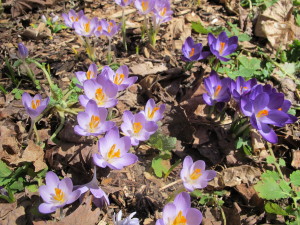
So what can you do now? As soon as the snow disappears you can collect a soil sample and send it off to your state university extension service. Just Google “soil test” and your state, and you will find where to send a sample and how to collect it. I usually sun dry a sample on a cookie sheet, and remove any bits of grass, roots and rocks. As a rule of thumb, it is good to collect your sample from the depth where roots will be. For most things, that is 4 to 6 inches deep.
If you live in a house that was built before 1978, its exterior paint probably has some lead in it. Lead paint has been shown to contaminate soil and to be picked up by plants; this is most severe within 20 feet of the house, or even further if you are on a hill. Testing for heavy metals can be expensive: in New Hampshire the test for it is $65. But if you have small children and will be gardening near the house, it is a worthwhile one-time investment. Children are most severely affected by lead poisoning.
Root crops are the worst offenders when it comes to picking up lead and arsenic, another heavy metal. Lead was an additive to gasoline up until 1996 in most states, and lead from exhaust can still be a problem within 100 feet of a major highway. Arsenic was used as an insecticide, particularly in apple orchards up until the 1980’s, either as lead arsenate or calcium arsenate. Heavy metal compounds like that do not dissipate or disappear easily or quickly.
So how can you improve your soil? In a word, compost. Good compost is biologically active, meaning that it is full of beneficial microorganisms – bacteria and fungi. Later, when my lawn has turned green, I may spread some compost on it to improve the soil. All I do is fling compost over the lawn with a shovel, and then use a lawn rake to even it out.
Half an inch of compost spread out over the lawn will help a lot, particularly if you have used chemicals on the lawn. Fertilizers and particularly “Weed-n-Feed” products inhibit the growth and survival of microbes that will give your lawn that springy feel when you walk on it barefoot this summer. Compost adds organic matter and carbon to feed microbes that can’t use photosynthesis to get their own food. Earthworms love compost, too. Add compost, and they will come and help to get it down into the soil.
I have, carefully, raked leaves off one of my bulb beds. I did so recently. I was delighted to see, beneath a layer of leaves, the tips of daffodils and other bulbs were showing. I didn’t walk into the bed, as that would compact the soil, so I just reached what I could from the edge. That meant the back of the bed stayed unraked for now.
I have been known to lay down boards to walk on to avoid soil compaction at this time of year. Six-inch wide boards cut in five-foot lengths are good: they are light enough to move around, but do a good job of distributing my weight. Two or three is all you need. And once, to avoid compacting the soil, I wore my snowshoes. The neighbors probably thought I was crazy!
This is a good time of year to do a little maintenance on your tools. Take a big, rough file and sharpen the edges of your shovels and hoes. Just try to mimic the angle that exists already. A sharp tool works so much better than a dull one.
I apply boiled linseed oil once a year to keep wooden handles from drying out. I paint it on, let it soak in, and then rub the handles with a rag to polish them up. The handle on my potato hoe, which I got from my family’s garage 30 years ago, is probably 50 years old – but still smooth, strong and splinter-free because I take good care of it.
So don’t rush into spring. Enjoy a warm lazy day from the deck and know that soon the soil will be dry enough to start raking.
Henry Homeyer has a new book: The New Hampshire Gardener’s Companion, Second Edition. This edition has 2 new chapters and updated information in all chapters. His e-mail is henry.homeyer@comcast.net.



